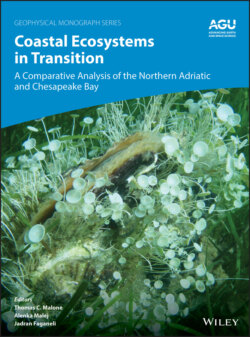Читать книгу Coastal Ecosystems in Transition - Группа авторов - Страница 14
1.1. WHY COASTAL ECOSYSTEMS AND WHY THE NORTHERN ADRIATIC SEA AND CHESAPEAKE BAY?
ОглавлениеCoastal ecosystems produce 80% of the world’s annual marine fish catch (Pauly et al., 2008) and provide an estimated $12 trillion annually in coastal ecosystem services (Barbier et al., 2011; Costanza et al., 2017; Koch et al., 2009; Solé & Ariza, 2019; Worm et al., 2006) upon which sustainable development depends (Malone et al., 2014; UNEP, 2006; Wood et al., 2018). Four major categories of ecosystem services have been recognized (MEA, 2005):
1 Supporting services that underpin the capacity of coastal ecosystems, e.g., presence of critical habitats and biodiversity, primary production of organic nutrients and oxygen, and nutrient cycling. For our purposes, critical habitats include both pelagic habitats of the water column and biologically engineered benthic habitats (coral and oyster reefs, seagrass meadows, kelp forests, salt marshes and mangrove forests).
2 Regulating services, e.g., climate control, prevention of coastal erosion, limiting the extent and impacts of coastal flooding, and maintenance of water quality.
3 Provisioning services, e.g., supplies of food, raw materials, and medicinal resources.
4 Cultural services, e.g., recreational, aesthetic, and spiritual benefits.
Anthropogenic pressures that impact the capacity of marine ecosystems to provide services can be divided into two broad categories:
1 local pressures that are occurring globally (e.g., nutrient enrichment, fishing pressure, coastal development);
2 global, climate‐driven pressures (e.g., ocean warming and acidification, sea‐level rise, acceleration of the water cycle, the El Niño–Southern Oscillation) that have local consequences.
Together, local and global pressures interact to impact the capacity of marine ecosystems to provide services, especially in the coastal zone where these pressures converge and people and ecosystem services are concentrated (Elliff & Kikuchi, 2015; Solé & Ariza, 2019).
The rationale for comparing the two coastal systems of the northern Adriatic Sea (NAS) and Chesapeake Bay (CB) is that: both are well studied, semi‐enclosed, river‐dominated ecosystems subject to anthropogenic nutrient enrichment; both provide similar, economically important services that have been subjected to similar pressures during the course of the Anthropocene (Zalasiewicz et al., 2010); and together they offer contrasts in geomorphology and circulation that modulate their responses to anthropogenic pressures (Cloern, 2001).
